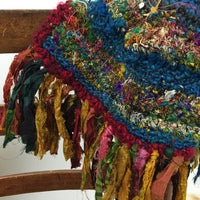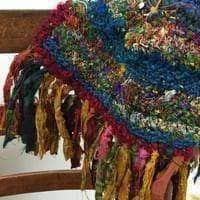
Crochet patterns can be a tricky thing to understand if you don't have a basic knowledge. Think back to when you learned how to cook. There was a little bit of learning the abbreviations but after that you were set! Here, I will show you some simple how-to's along with some abbreviations and symbols. These will help you on your way to understanding the basics of reading crochet patterns.
By the way, don't worry about memorizing everything. It will come with time and you can always access this post as a reference too!
So, let's get you started reading crochet patterns!
First off, crochet patterns are worked in rows or rounds. Rounds is abbreviated "rnds". When you first read the pattern it will tell you if you're working in rows or rounds. Sometimes patterns call for both too!
Next is the skill level. Don't worry there is nothing foreign here. Beginner, easy, intermediate and advanced are the basic difficulty levels. Don't be afraid to try something new. I learned so much by trying the next step up in patterns. That's how you get better. Many of Darn Good Yarn's crochet patterns fall in the beginner to easy range.
Count count count! Make sure to count your stitches and match it up to the pattern. I remember when I first started and I would swear I had the right count but when I verified I realized that I was somehow off. Don't worry! You will get better with time. That's part of the fun and learning how to improvise.
Ok now you might moan.... but.... CHECK YOUR GAUGE. I admit it. I hate checking my gauge and making swatches. It seems like such a waste of time. But trust me, I have made too many finished items that straight up don't fit. Now that's a waste of time! Do it! And remember things like stress can affect your project too. If your gauge is too small use a larger hook and if it's too big use a smaller hook. Easy as that!
Like all things, diving into a new crochet pattern can be scary. It seems like a foreign language. But don't worry. Take it one step at a time and you will find that you can work through just about anything with patience and taking it step-by-step.
If you're still timid you can always take a class in a local shop or online. There are amazing resources out there! Google is your friend:)
Now let's go through a sample line of a pattern. Here's what you might see:
Row 1: With size I hook, ch 20, sc in 2nd ch from hook and in each ch across, turn.
(19 sc)
Now let's talk through this in plain English.
Row 1: Using a size I crochet hook, make 20 chain stitches, single crochet in the second chain stitch from the hook and in each chain stitch across, turn. (There are 19 single crochets at the end of this row.)
See it's not so bad.
Refer to this site often for lists of abbreviations and symbols, videos and explanations of individual stitches and helpful tips and hints. Armed with these tools, the desire to learn and a little patience, you’ll soon be on your way to reading crochet patterns!
Abbreviations, Symbols and Additional Terminology
Abbreviations
beg....................... begin/beginning
bpdc..................... back post double crochet
bpsc...................... back post single crochet
bptr....................... back post treble crochet
CC......................... contrasting color
ch.......................... chain stitch
ch-......................... refers to chain or space previously made (i.e. ch-1 space)
ch sp..................... chain space
cl........................... cluster
cm......................... centimeter(s)
dc......................... double crochet
dc dec................... double crochet 2 or more stitches together, as indicated
dec........................ decrease/decreases/decreasing
dtr......................... double treble crochet
fpdc...................... front post double crochet
fpsc...................... front post single crochet
fptr........................ front post treble crochet
g........................... grams
hdc........................ half double crochet
hdc dec................. half double crochet (decrease) 2 or more stitches together, as indicated
inc......................... increase/increases/increasing
lp(s)....................... loops(s)
MC........................ main color
mm........................ millimeter(s)
oz.......................... ounce(s)
pc......................... popcorn
rem........................ remain/remaining
rep........................ repeat(s)
rnd(s)..................... round(s)
RS......................... right side
sc.......................... single crochet
sc dec................... single crochet (decrease) 2 or more stitches together, as indicated
sk.......................... skip(ped)
sl st....................... slip stitch
sp(s)...................... space(s)
st(s)....................... stitch(es)
tog........................ together
tr........................... treble crochet
trtr......................... triple treble
WS........................ wrong side
yd(s)...................... yard(s)
yo......................... yarn over
Symbols
Crochet patterns use symbols to signal repeated text, special instructions and clarifying information.
( ) Work instructions within parentheses in place directed; used to indicate collective stitch groups worked as one procedure in the same place; used for additional or clarifying information, indicated in italic text.
Examples:
(3 dc, ch 2, 3 dc) in next corner sp
(sc, hdc, 3 dc, hdc, sc) in next st
(48 dc) – indicating stitch count at end of row or round
(88 [94, 106, 112] sc) – indicating multiple stitch counts for additional garment sizes or rows/rnds.
Row 1 (RS): – indicating front of work
[ ] Repeat instructions within brackets as directed; also used to indicate additional or clarifying information.
Examples:
[dc in next dc, cl in next ch-1 sp] 5 times
[dc in each of next 3 dc, shell in next shell] across to next corner
Child’s 2 [4, 6, 8] – indicating multiple finished garment sizes
Rows 29–36 [31–38, 31–40]: – indicating additional rows/rnds for multiple sizes
Sc in each of next 4 [5, 6] sts – indicating additional instructions for multiple sizes
{ } Repeat instructions within braces as directed; used to indicate a set of repeat instructions that are worked within a bracketed set of repeat instructions, or to indicate multiple repeats of stitch patterns that are part of a collective stitch group contained within parentheses.
Examples:
[dc in each of next 3 sts, {shell in next ch-1 sp} twice] 4 times
[{ch 5, sc in next ch sp} twice, ch 5, sk next dc, dc in next dc, {ch 1, sk next dc, dc in next dc} 6 times] twice
({dc, ch 1} 5 times, dc) in next ch-2 sp
({sc, ch 3} 3 times, hdc, ch 2, hdc, ch 3, {sc, ch 3} twice, sc) all in corner sp
* Repeat instructions following a single asterisk or between two single asterisks as directed.
Examples:
Ch 1, sc in first sc, *ch 1, sk next ch-1 sp, sc in next sc, rep from * across
*Sc in each of next 2 sts, 2 sc in next st, rep from * around
Ch 1, *(sc, dc, tr, dc, sc) in next ch-2 sp, ch 2, sc in next hdc, ch 2, rep from * 6 times
Ch 1, sc in same st, sc in each of next 22 sc, *[2 sc in next sc, sc in each of next 3 sc] twice, 2 sc in next sc*, sc in each of next 23 sc, rep between * once, join in beg sc.
** This symbol has two uses, as follows:
1.Repeat instructions between or from double asterisks as directed, usually in combination with a set of single asterisk instructions.
Examples:
Ch 1, *(sc, 2 dc, ch 1, 2 dc, sc) in corner sp, (sc, 2 dc, sc) in next ch-3 sp, **ch 1, sk next ch-1, sl st in next ch-1 sp, ch 1, sk next ch-1**, [(sc, dc, ch 1, sc) in next ch-3 sp] 3 times, rep between ** once, (sc, 2 dc, sc) in next ch-3 sp, rep from * 3 times, join.
Sl st in next st, sl st in corner ch sp, ch 3, dc in same sp, *[(picot, 2 dc) 3 times in same sp, **2 dc in next ch sp, (picot, 2 dc) twice in same sp, rep from ** across to next corner ch sp], 2 dc in next ch sp, rep from * twice, rep between [ ] once, join.
2.Work a partial set of repeat instructions as indicated by double asterisks.
Examples:
*Ch 3, (sc, ch 3, sc) in next ch-2 sp, ch 3**, V-st in next dc, rep from * 3 times, ending last rep at **
2 sc in first st, *ch 2, sk next st, cl in next st, ch 2, sk next st**, 2 sc in next st, rep from * around, ending last rep at **
à Repeat instructions between or from diamonds as directed, usually in combination with single asterisk instructions.
Examples:
Ch 1, sc in same sc, *àsk next ch-2 sp, [sc in next sc, ch 3] 4 timesà, sc in next sc, sk next ch-2 sp, sc in next sc, rep from * 6 times, rep between ààonce,sc in next sc
({Sl st, ch 3} 3 times, sl st) in corner sp, ch 3, sk next 3 sts, (sl st, ch 3, sl st) in next st, ch 3, sk next 3 sts, (sl st, ch 3, sl st) in next ch-2 sp, àch 3, sk next 3 sts, sl st in next st, ch 3, sk next 3 sts, (sl st, ch 3, sl st) in next ch-2 sp, rep from à across to last 7 sts before corner sp, ch 3, sk next 3 sts, (sl st, ch 3, sl st) in next st, ch 3, sk next 3 sts, rep from * around, join.
Additional Terminology
Work even: Work in pattern already established without increasing or decreasing stitches.
 Rewards
Rewards

